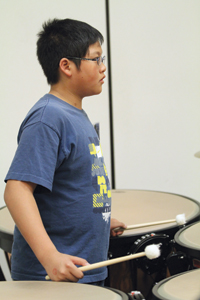 The unending struggle for musicians is to make their physical technique match their musical ideas. Instrumentalists may find that technical difficulties can hinder their focus on the sound of the music they are trying to produce, and percussionists face perhaps the greatest degree of this complication because of the wide variety of percussion instruments and numerous ways of playing them. Although percussionists must dedicate time and effort to technical study, aural skills are also a crucial element of their musical growth. Here are tips for teaching aural skills in pitch, rhythm, and timbre to percussionists at any level.
The unending struggle for musicians is to make their physical technique match their musical ideas. Instrumentalists may find that technical difficulties can hinder their focus on the sound of the music they are trying to produce, and percussionists face perhaps the greatest degree of this complication because of the wide variety of percussion instruments and numerous ways of playing them. Although percussionists must dedicate time and effort to technical study, aural skills are also a crucial element of their musical growth. Here are tips for teaching aural skills in pitch, rhythm, and timbre to percussionists at any level.
Pitch
Perhaps the most obvious application of a keen sense of pitch discrimination is in tuning the timpani. Percussionists need to be able to imagine clearly the pitch they intend to tune the drum to. Before a performance, or between pieces, they generally have time to accomplish this. However, pitch changes in the middle of a piece require highly skilled and efficient ears. Timpani tuning gauges may be helpful for approximating the pitch change, but ultimately the students’ ears must determine accuracy.
The first step students must master is precise pitch matching through singing. In lessons or sectionals the director should play a note and then have students sing it. Another option is for the director to sing notes for students to match. If students are shy or nervous, I encourage them to hum rather than sing at first, because often they are more comfortable doing that.
If they are completely off key, it is best to work from where they are. Untrained students sometimes sing in their speaking voice, at the bottom of their range, so I will meet them at the pitch they gave and have them go up, like a siren, until they hit the pitch. If they don’t realize they have hit it at first, you can signal to them when they match the note. In my experience, that gap becomes smaller and smaller as they start out closer and closer to the right pitch. Eventually they get to the point where they can match pitch from the beginning. It isn’t enough to ask an off-pitch student to try again, you have to go to where they are and teach them physically through experience how it sounds to line up with the pitch.
Repeated practice at an accurately tuned keyboard instrument or with an electronic tuning device is essential. Students can use an electronic tuner to check their singing against the pitch source. No matter how technically proficient a student becomes, the timpani will never be properly tuned if the ear is not trained to hear and match pitches.
When timpanists are confident in pitch-matching abilities, they can practice interval and context pitch skills, two skills on which timpanists depend. Interval skill requires hearing and singing two or more notes at specified intervals, while context skill requires hearing and singing notes within a given key. For example, interval skill might be singing a perfect fourth below a given pitch, in order to establish that interval across two timpani to play an exercise or repertoire piece. An example of context skill is picking a note out of a chord and using that pitch to tune for a subsequent section of a piece. For example, if the band is playing a C major chord, the timpanist should be able to hear the E in that chord and retune the drums based on that. Ideally, students will learn to use these aspects of pitch skill in tandem, allowing one to reinforce the other.
Although singing out loud is important for developing pitch discrimination and understanding, it also helps students build internal musical connections, and singing out loud is a great way for teachers to assess students’ inner hearing accuracy. Students who can match pitch easily should move on to silent singing, or producing pitches in the mind without making a sound. This step will strengthen students’ pitch abilities because all aspects are processed internally. In addition, students will need to sing silently when tuning the timpani during rehearsals and performances anyway.
Silent singing is difficult to assess. This first step does not prove that students are doing it, but it is a good way of reminding them to do it. When students are working on pitch-matching exercises, have them leave some space between hearing the pitch and matching it. Instruct students to hear the pitch internally and then sing what they hear in their heads. Students who can successfully match pitch after waiting are much more likely to be remembering the pitch without singing, and you can assess that by whether they are on pitch when they sing.
The best long-term process is to at first just plunk a note and have students sing it without thinking too much. When they can sing the correct pitch, introduce them to the idea of matching pitch without making a sound. This is more difficult for students, who usually want to sing the note as soon as they hear it. It is an unusual order in which to learn concepts; going from singing then hearing the note internally to hearing the note internally before singing is counterintuitive. Students need to be able to sing silently, because they cannot just start singing pitches out loud while the band is playing. Convincing them that they will really need this skill to play timpani will encourage them to do it.
Percussionists can also use singing to develop melodic interpretation skills. On mallet keyboard instruments, students need to decide how to shape musical phrases. If students can sing what they hear in their minds, they can make musical decisions without the complication of instrumental technique. Ultimately, hearing, singing, and instrumental performance become one fluid process, but as students are learning to integrate musicality and technique, they sometimes must isolate each element of this sequence for practice.
Rhythm
Mallet keyboard players mostly focus on pitches for phrasing, but artistic performance for percussionists also includes rhythmic phrasing. Students must be able to interpret rhythmic phrases in ways that contribute to overall ensemble expression. For example, if a snare drum part has eight eighth notes in a measure, and there are no dynamics or accents marked, chances are that a seasoned player is not going to play all eight notes exactly the same; there are very few instances where someone would do that. This is where inner hearing comes in. Students can figure out the best way to shape or accent those notes. There is no pitch or melody, but based on what else is going on in the ensemble, students should be able to come up with some way of playing those eight notes musically. Students might decide the volume should rise and fall, or they might decide to add accents. They should not change the rhythm, but even without pitch it is possible to shape notes.
Singing is a key approach to this. As they listen to the rest of the ensemble, they can silently experiment with ways that a given rhythmic phrase might complement the group effort. Once they have firmly established an aural image, via audible and silent singing, they can transfer that image more easily to playing. As students develop confidence in their singing abilities, they realize that they can manipulate nuance in a given phrase and create fresh interpretations.
Percussion players must also manage rhythmic coordination of multiple parts. For example, in a drumset or multiple percussion piece, students sometimes play layered subdivisions or polyrhythms in various combinations of hands and feet. Layered subdivisions on a drumset might be the right hand playing eighths on the hi-hat while the bass drum is playing quarters and the snare is on beats two and four. There are multiple subdivisions going on simultaneously. Polyrhythms are similar but not necessarily multiples of each other; it could be five notes against three or a similarly odd ratio.
This same skill is necessary even in many single percussion parts in large ensembles, where percussionists must coordinate the parts of the others internally while playing. Because percussion assignments in a large ensemble are often one player to a part, each player is responsible for making the section, and the overall ensemble, sound great. Instructors can check how well percussionists are listening to each other and grasping the big picture by having them sing or chant another part while playing their own.
Just as wind and string players learn to play unmeasured or flexible vibrato, percussionists must be able to play unmeasured rolls to sustain notes. Whether a single-stroke, double, or buzz roll, percussionists must be able to create the sound of sustain without the distraction of precise subdivision in the rolled strokes. For example, a snare drummer may need to play seven, eight, or nine buzz strokes in a half note roll, while keeping track internally of two quarter note beats for duration accuracy. To develop this polyrhythmic ability, students can practice with a metronome providing quarter notes, while they supply varying numbers of buzz strokes within the half note duration. Eventually, they must feel the quarter note pulse internally, fusing the two parts.
Timbre
Although rhythmic training is important for successful performance, overemphasis on rhythm can draw attention away from the quality of sound percussionists are producing. Instrumental teachers should experiment with percussion timbre possibilities, then coach their students through the techniques necessary to produce those sounds, and, most importantly, teach their students to discern, explore, and create percussive timbres themselves through their aural training.
A single suspended cymbal, for example, holds vast potential for timbre variations, depending on, for example, stick or mallet choice, striking area on the cymbal, and type of stroke. Consider a metal triangle beater versus a snare drum stick versus a heavily wrapped yarn mallet. They are all going to make different sounds even if all other variables are the same. The size and material of the mallet make a big difference, so the triangle beater will be different in every way from the yarn mallet. There is a different attack, focal point of the sound, and decay, as well as an entirely different spectrum of overtones. Striking area differences can be on the bell versus on the rest of the cymbal, but there is also a big difference between close to the bell and out near the edge. It is also possible to play sideways on the cymbal, hitting only the narrow edge, which produces a different sound as well. Type of stroke refers to the force of the stroke, stick height, velocity, single, double, or buzz stroke. Even if type of beater and striking area remain the same, the type of stroke will also create marked differences in timbre.
Percussionists need time and opportunities to explore how each of their instruments can be played to specific musical effect. Wise instructors would seek ways to make these opportunities available to percussionists while rehearsing other sections of the ensemble. As percussionists begin to discover and invent more ways of approaching their instruments, they build a wider timbre vocabulary in the inner ear, improving their interpretive decisions overall.
Successful performance depends not only on technical prowess, but also on the quality of the musical ideas projected through that technique. Instructors should help percussion students develop aural skills for musical performance and then encourage them to sing to develop internal aural images of percussive sound. Coaching percussion students to develop accurate aural perception, clear aural imagery, and creative approaches to interpretation will benefit the entire ensemble.






